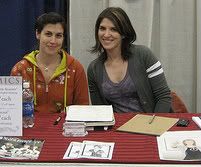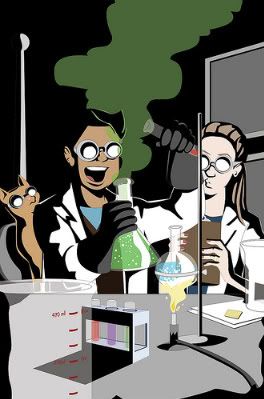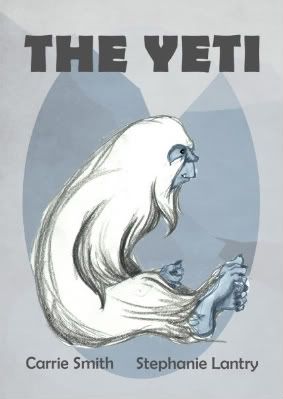 The Alternative Press Expo is a small convention that is geared to, as you can guess, the alternative facets of what the comics industry has to offer. What’s more than that is APE is as laid back a comic convention as you will find. Small shows will do that simply because smaller size means more attention, and the increased ability to interact with others in the comics community.
The Alternative Press Expo is a small convention that is geared to, as you can guess, the alternative facets of what the comics industry has to offer. What’s more than that is APE is as laid back a comic convention as you will find. Small shows will do that simply because smaller size means more attention, and the increased ability to interact with others in the comics community.
That’s whether it’s fans amongst professionals, professionals among their peers, or otherwise. So inevitably, this means discovering new creators and new comics in a way that’s different from other cons.
I first met Stephanie Lantry and Carrie Smith a few years back thanks to the online community that is the now defunct Brian K. Vaughan message board, the Cabal. As Conjoined Comics, the quick-witted indie-creators have collaborated to self-publish their own comic, To the Power Against, mini-comic Emogician (which the description should be pretty self-explanatory), and their newest book The Yeti, in a format that is quite unlike the first two. Recently at APE, I got a chance to chat with these two creators.
Joey Pangilinan: How did you two first meet, and come to start collaborate with each other?
Carrie Smith: We had a venn diagram of friends that met in the middle mostly through Star Wars.
Stephanie Lantry: We all knew people who lined up for the Star Wars prequels in Hollywood, and we just kind of knew people involved in that. So it was George Lucas who brought us together. But as far as actually collaborating, we were at a friend’s party one night, and Carrie mentioned one idea she had that might make a good comic.
CS: Well, To the Power Against was actually an idea I had for a novel. But there was so much of it that’s so much more visual. Where there are things that needed to happen in one shot, or one panel. “Would it work as a film? Or better as a comic?” So we just sat down, and got to talking about that, and decided to give it a try.
SL: That same night, we came up with Emogician.
CS: That’s right.
JP: In To the Power Against, the heroine, Catalina microwaves a burrito an extra five seconds than it says on the directions, and because of that, a lot of improbable stuff starts to happen. How did this idea all come about?
CS: I wanted to do a story that was just unusual. The kinds of stories I like to write have people having very real emotions, very real relationships. But I like to put them in situations that are somewhat absurd. That’s just the kind of story I like to do. So the idea of having somebody minding her own business, and going on with her life, and then to have this super power about controlling probability. Well, why not give it to her in a completely ridiculous and improbably way.
The whole thing about her power is that it’s not magic It’s a really improbable string of events. The idea that she was touching something electrical that was conducting this field at the moment when it happened could make sense, but it’s ridiculous, and the implied irony that the universe is getting back at her for cooking that burrito five seconds longer than it said on the directions is just silly.
So it was just finding something to fit in with the whole scope of making ridiculous things happen that we had to christen her with that power in a completely absurd way, and then have her have to react to it.
JP: Emogician. Your mini-comic. Will we ever see the origins of the delightful lead?
SL: An origin of Emogician? Sure.
CS: Aren’t the origins clear? Spoiled suburban child gets job as magician but can’t handle it… Oh, I guess we could do an origin.
SL: It would probably be pretty good.
JP: As far as the Yeti, it’s a unique digest sized book that you guys have put together that is both prose and illustrations. How did this come about?
CS: The genesis of it was something for us was looking for something new to do together, and also Stephanie has these awesome illustration skills. So giving her something she can do in color that would showcase another facet of her talent. The story itself is something I’ve had for several years.
It was a story I’d written for a birthday for a friend of mine, and it was just like, we were doing crappy jobs, and getting down on feeling like all you ever do is work to pay for stuff, and what’s really the point of life or whatever. Oddly enough, it’s our friend who is the model for Xi Chen (To the Power Against) is the person who’s birthday the Yeti was for.
JP: Do you guys have any more plans for this format?
CS: Nothing at the moment. We still have to finish To the Power Against. But who knows what we’ll be doing.
JP: There’s supposed to be a total of six issues of To the Power Against, with two more to still be released. What can we expect?
CS: It’s six issues for this first story arc. But I have at least three arcs planned. There’s definitely some progression that’s gonna happen, for sure.
JP: What was the difference in approach in how you’d draw To the Power Against versus The Yeti?
SL: I grew up watching cartoons like a lot of Warner Brothers animated stuff. I always kind of wanted to do animation, and this is something kind of in that vein. Something simple, and very expressive, and I approached it that way just like the old Chuck Jones cartoons. I’ve always done different styles depending on the project or what somebody wanted as a commission. It’s all generally the same, but I sort of move around different styles.
I’ve done original comic books for about five years, but before that I used to sit in artists alley, and do original sketches and commission work and things. I’ve been doing that since 1994. So I was 13 when I did my first convention in Michigan, selling sketches for a couple bucks. I think I broke sixty conventions not too long ago. I sorta grew up doing that.
JP: At conventions, the issues sell well? What’s the response?
CS: We do alright, actually. We get a lot of people who come back who’ve read the first one, or the first two, and they’re like “okay, I need three and four.” So it’s nice to see a lot of the same faces. We do alright. It’s not like we’re Stephen King, but its not that bad either.
JP: Well what would you say is the hardest part about keeping up with the demands of being independent comic creators?
SL: The hardest part is finding time to fit it in our daily schedule. When you’re publishing it yourself, you gotta get that money from somewhere, and that usually means a day job. Some people are really lucky, and make enough money with it, that that’s what they do. Penny Arcade is a good example. They just started doing it, and started making money at that, and it’s all they do now.
Some are lucky in that they have a related day job, then there’s some of us who have day jobs totally separate. The biggest challenge is finding the time and the energy to put into it at the end of the day when you’ve already worked nine hours somewhere else, and come home. It’s like a second job. It’s worth it, though. It’s something we enjoy enough. Hopefully, it’ll pay off at some point.
CS: I think it’s slightly easier for me to find time to do stuff, because I can sit there and write an entire script in a couple of days if you commit yourself to a whole weekend of drinking coffee and banging it out. And you can also have a little notebook at work, and just put down ideas. So you can crowbar your writing in. For Stephanie, it requires more space, more supplies, more physical exertion.
I think the biggest challenge we have is just finding the time to complete all the physical labor of putting together a book, and manage to pay the rent at the same time. I feel like if we didn’t have to go to our day jobs, we’d be cranking these out once a month, for sure.
JP: How’s the collaborative process between you two?
SL: When we first started, she had never written a comic before, and there are some writers who write specifically comic book scripts. They set up the panels, and angles. Some writers are super specific. But Carrie had only done prose and screenplay types before, so I told her to go with the screenplay. The interior/exterior shots to give me some basic directions, and I’ll figure it out from there, because I had a better sense of how to lay out a page, and how that has to work.
So we’ve pretty much stuck with that. She just kinda give it to me in almost a screenplay form, and some stage directions, and if there’s something really specific she wants, she’ll put that in there. But as far as the layout, the flow, and all of that, I’ll handle the rest of it
CS: Yeah, I’m not gonna say that someone looks over their shoulder at such and such an angle. I’ll just say something explodes, or so and so gets stabbed in the face with a fork.
SL: That has not happened, yet.
CS: Of course, now I feel it’s gonna have to happen. But I just try to leave it stripped down, and going in the right direction so she can work with it. But that’s knowing you’re doing something that’s absolutely collaborative. That won’t make sense until two people have worked on it.
So it’s just a different mind-set. But for the Yeti, it’s two complete interpretations that are of the same story. You can look at a series of Stephanie’s paintings, and go “oh, that’s about a Yeti, and so on, and so on…” So she’s told the story in her way, and then there’s the prose.
But when you know that all that you’re getting is the prose, you have to obsess over every single word. Like is this gonna make someone anxious, is this gonna make them see the color blue, is it gonna make them see something huge, or small, or whatever.
Like I said, with Stephanie, I could just say something explodes, and she’s gonna do the leg-work that I have to do with vocabulary when I’m by myself.

jaime
October 28, 2009 at 12:41 amCool.
Interview: Stephanie Lantry and Carrie Smith of Conjoined Comics Scripts Rss
October 27, 2009 at 3:25 pm[…] post: Interview: Stephanie Lantry and Carrie Smith of Conjoined Comics By admin | category: Script??????? | tags: among-their, articles-super, comics, […]
Interview: Stephanie Lantry and Carrie Smith of Conjoined Comics | Pulplit Magazine
October 27, 2009 at 3:08 pm[…] Read more: Interview: Stephanie Lantry and Carrie Smith of Conjoined Comics […]